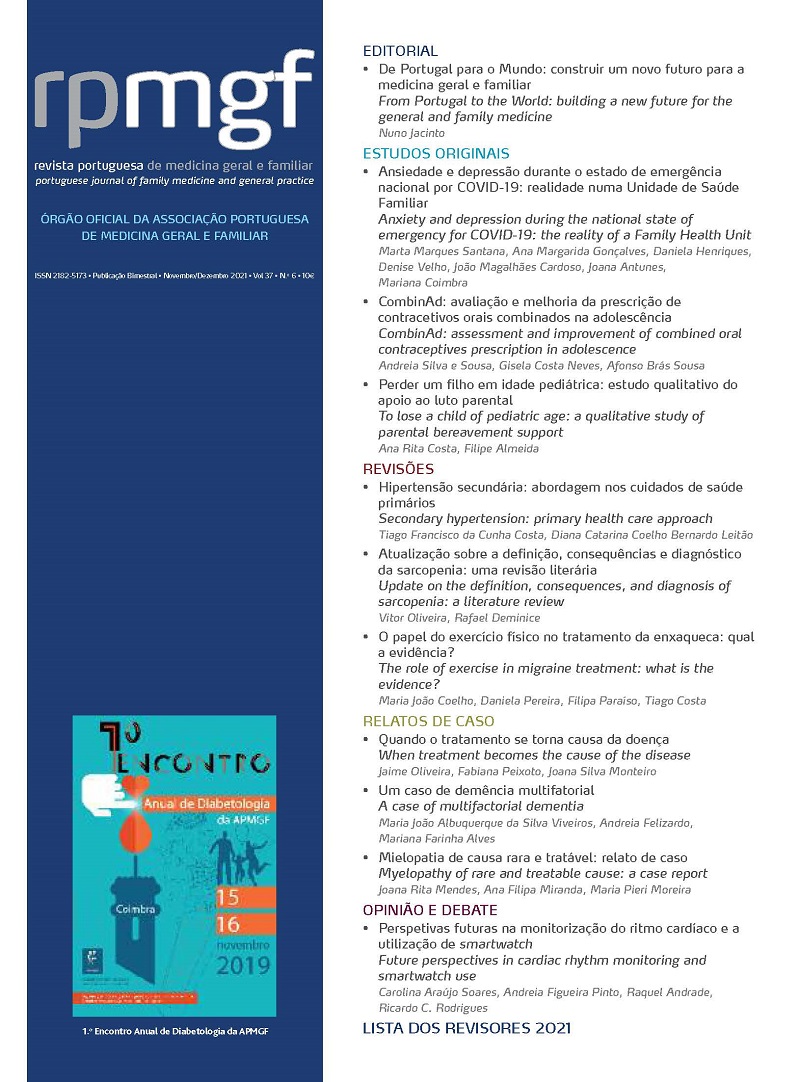When treatment becomes the cause of the disease
DOI:
https://doi.org/10.32385/rpmgf.v37i6.12882Keywords:
Headache, Migraine, Analgesics, Drug abuse, Medication overuse headacheAbstract
Introduction: Headache is a common complaint and self-medication is not uncommon. This article reports the approach to medication overuse headache (MOH) in a patient who self-medicated with analgesics, whose intervention was hampered by poor adherence to medical follow-up.
Case Description: 41-year-old woman, cleaning employee. History of migraine since adolescence, which worsened after her second delivery, presenting with weekly episodes without relief after several treatments were prescribed. In 2015, after referral to a Neurology consultation, she started prophylaxis with amitriptyline, which she suspended, missing the follow-up appointment. In the three years that followed, she only attended primary care consultations motivated by acute illness, without regular appointments. On Jan/2018, she went to the emergency department due to persistent migraine, and again she was referred to a Neurology consultation, where it was detected that she self-medicated with over twenty suppositories of paracetamol + codeine in each episode of migraine. Topiramate was prescribed and a new consultation was scheduled. She suspended topiramate due to weight loss and missed the follow-up appointment. On Jan/2020, she consulted her family doctor reporting sadness, insomnia, constipation, and weight loss. She maintained the migraine and the use of suppositories. After screening for organic causes, she was diagnosed with depressive disorder and MOH. It was explained that drug abuse could cause headaches and treatment would involve the cessation of that medication. She was medicated with antidepressants, and, in the next consultations, weight recovery, improved mood, less frequent headache, and reduced suppository use until withdrawal were documented.
Comment: MOH develops due to the excessive use of headache relievers, and the suspension of medication is the only effective treatment. This patient maintained a situation of medication overuse for eight months, resulting in MOH and risk of liver toxicity. The family doctor is crucial to early detecting and addressing drug abuse.
Downloads
References
European Headache Federation. Princípios europeus da abordagem das cefaleias comuns nos cuidados de saúde primários [homepage]. Lisboa: Sociedade Portuguesa de Cefaleias; 2010. Available from: http://www.cefaleias-spc.com/comunidade/documentos/
Wootton RJ, Wippold II FJ, Whealy MA. Evaluation of headache in adults. UpToDate [Internet]; 2020 [updated 2021 Aug 12; cited 2020 Feb 10]. Available from: https://www.uptodate.com/contents/evaluation-of-headache-in-adults
Headache Classification Committee of the International Headache Society (IHS). The international classification of headache disorders, 3rd ed. Cephalalgia. 2018;38(1):1-211.
Becker WJ, Findlay T, Moga C, Scott NA, Harstall C, Taenzer P. Guideline for primary care management of headache in adults. Can Fam Physician. 2015;61(8):670-9.
Grupo de Estudio de Cefaleas de la SEN. Guías diagnósticas y terapéuticas de la Sociedad Española de Neurología 2015. Madrid: Sociedad Española de Neurología; 2015. ISBN 9788415198994
Rebelo L. A família em medicina geral e familiar: conceitos e práticas. Coimbra: Almedina; 2018. ISBN 9789724073132
Downloads
Published
How to Cite
Issue
Section
License
Copyright (c) 2021 Portuguese Journal of Family Medicine and General Practice

This work is licensed under a Creative Commons Attribution-NonCommercial-NoDerivatives 4.0 International License.
The authors will assign to the RPMGF the sole right to publish and distribute the content of the manuscript specified in this declaration via physical, electronic, broadcasting or any other medium that may come into existence. They also grant the RPMGF the right to use and exploit this manuscript, in particular by assigning, selling or licensing its content. This permission is permanent and takes effect from the moment the manuscript is submitted, has the maximum duration allowed by applicable Portuguese or international law and is of worldwide scope. The authors further declare that this assignment is made free of charge. If the RPMGF informs the authors that it is not going to publish their manuscript, the exclusive assignment of rights ceases forthwith.
The authors authorise the RPMGF (or any entity it may appoint) to act on their behalf when it believes that copyright may have been infringed.





